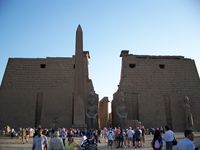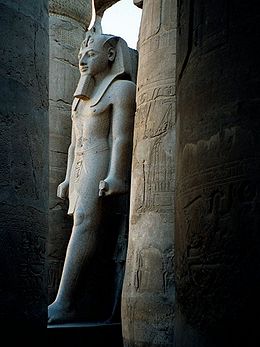Luxor Temple


Luxor Temple is a large Ancient Egyptian temple complex located on the east bank of the River Nile in the city today known as Luxor (ancient Thebes) and was founded in 1400 B.C.E.
Known in the Egyptian language as ipet resyt, or "the southern sanctuary", the temple was dedicated to the Theban Triad of Amun, Mut, and Chons and was built during the New Kingdom, the focus of the annual Opet Festival, in which a cult statue of Amun was paraded down the Nile from nearby Karnak Temple (ipet-isut) to stay there for a while, with his consort Mut, in a celebration of fertility – whence its name.
The earliest parts of the temple still standing are the barque chapels, just behind the first pylon. They were built by Hatshepsut, and appropriated by Tuthmosis III. The main part of the temple - the colonnade and the sun court were built by Amenhotep III, and a later addition by Rameses II, who built the entrance pylon, and the two obelisks (one of which was taken to France, and is now at the centre of the Place de la Concorde) linked the Hatshepsut buildings with the main temple.
To the rear of the temple are chapels built by Tuthmosis III, and Alexander. During the Roman era, the temple and its surroundings were a legionary fortress and the home of the Roman government in the area.
See also
- Luxor Obelisk in Paris

Gallery
 Luxor Temple, from the east bank of the Nile |
Hundreds of sphinxes once lined the road to nearby Karnak |
A well preserved sphinx |
 The massive First Pylon |
|
The red granite obelisk |
The central corridor of the temple |
 Islamic mosque over pharaonic temple |
 Sitting Ramesses II Colossus inside Luxor Temple |
 Closeup of the same Colossus |
 Amenhotep's colonnade from the peristyle court |
The east side of the peristyle court of Amenhotep III |
Roman mural in an inner chamber |
 Central corridor and four colossi by night |
 Closeup of illuminated red granite obelisk |
 Sitting Ramesses II Colossus inside Luxor Temple by night |
 Wall inscription |
External links
- Johnson, N. B.: Temple Architecture as Construction of Consciousness..., Arch. & Comport. / Arch. Behav., Vol. 4, no. 3, pp. 229–249 (1988), p. 233f.
- Luxor Temple of Thebes
- Temple of Luxor images
- [1] The Nativity Scene in the Temple of Luxor
|
||||||||||
